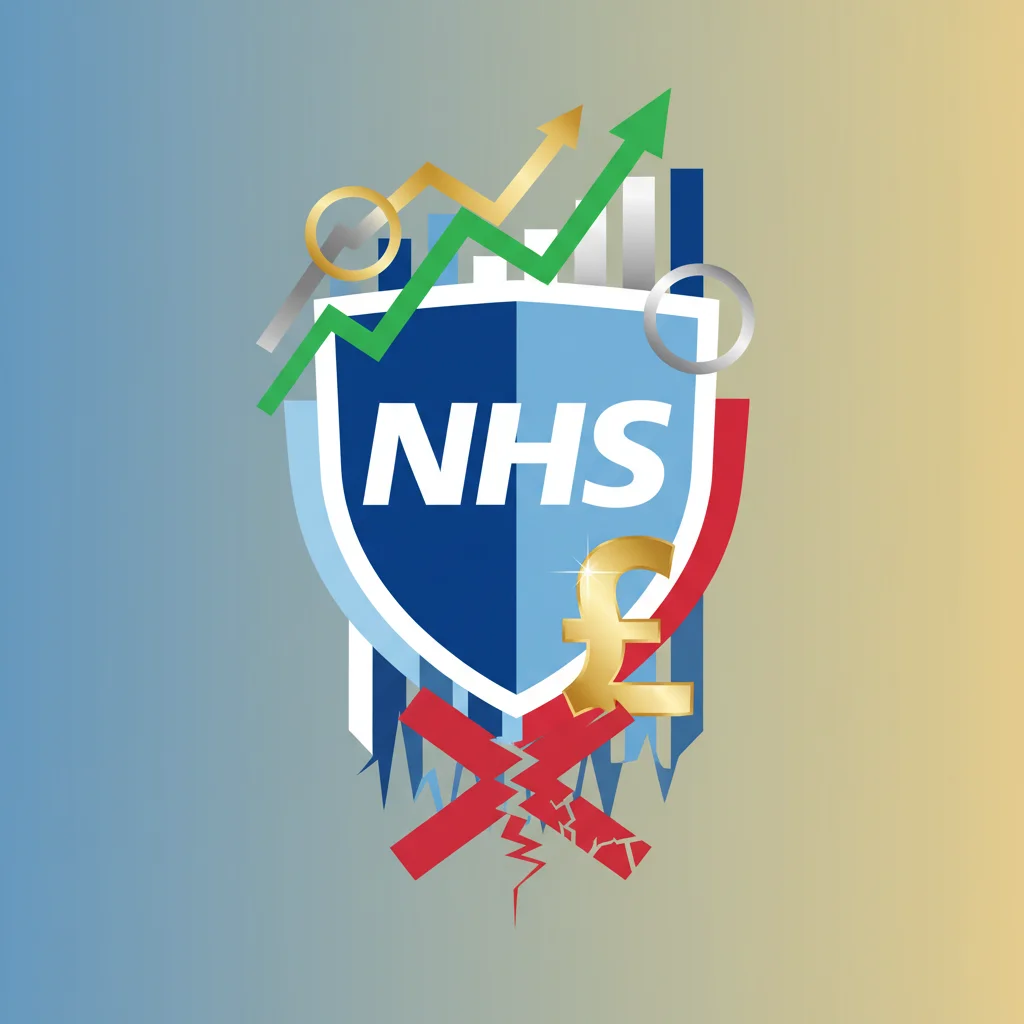
NHS plc: Could Trading Healthcare on the Stock Market Be the Ultimate Cure?
The Diagnosis: A National Treasure on Life Support
The UK’s National Health Service (NHS) is more than just a healthcare system; it’s a cornerstone of British identity, a symbol of collective responsibility born from the ashes of World War II. Yet, this revered institution is facing a crisis of unprecedented scale. Decades of underfunding, an aging population, the rising cost of advanced medical treatments, and the seismic shock of a global pandemic have left it with staggering waiting lists and a workforce stretched to its breaking point. According to the British Medical Association, the waiting list for consultant-led elective care in England stood at a staggering 7.54 million in January 2024.
For years, the debate over its future has been a political tug-of-war, with solutions typically confined to promises of more government funding or marginal efficiency drives. But what if the answer lies not in political rhetoric, but in the radical principles of finance, technology, and the open market? A recent letter to the Financial Times by Myles Pinfold proposed a thought experiment so audacious it borders on heresy: what if we floated the NHS on the stock market?
This isn’t just about privatization in the traditional sense. It’s a proposal to fundamentally re-engineer the economics of healthcare, transforming every citizen into a shareholder and every patient into a consumer. It’s an idea that merges public ownership with market dynamics, a concept we’ll call “NHS plc.” In this analysis, we will dissect this groundbreaking proposal, exploring its potential as a masterstroke of financial innovation and its profound risks to the very soul of universal healthcare.
The Prescription: Unpacking the “NHS plc” Blueprint
The proposal to transform the NHS into a publicly listed company is a multi-faceted strategy that borrows heavily from the worlds of corporate finance and the stock market. It’s a radical departure from the current tax-funded, state-managed model. Let’s break down the core mechanics of this financial-economic experiment.
Step 1: The Initial Public Offering (IPO) of a Nation’s Health
The first step would be to structure the NHS as a single corporate entity—”NHS plc”—and list it on the London Stock Exchange. However, this wouldn’t be a typical IPO where shares are sold to institutional investors. Instead, in an act of mass economic empowerment, shares would be distributed to every citizen of the United Kingdom. Suddenly, every individual in the country would not just be a user of the health service, but a direct owner with a tangible, tradable stake in its success.
Step 2: From Taxpayer to Shareholder-Investor
This universal share allocation is the lynchpin of the model. It shifts the citizen’s role from a passive taxpayer to an active shareholder. The performance of the NHS would no longer be an abstract political issue but would have a direct impact on the financial asset held by every person. This could, in theory, foster a powerful sense of collective ownership and demand for accountability and efficiency that transcends the four-year election cycle.
Step 3: The “Health Voucher” – A Dividend for Well-being
As a publicly traded company, NHS plc would still receive its core funding from the government (exchequer funds). However, instead of this money being used to directly fund services, the company would use it to issue an annual dividend to its shareholders—the citizens. This dividend wouldn’t be paid in cash but in the form of a “health voucher.”
This voucher would be a piece of financial technology, a digital credit that represents a citizen’s entitlement to healthcare for that year. The value of this voucher would be tied to the performance of NHS plc and the level of government funding, creating a direct link between the system’s efficiency and the individual’s healthcare purchasing power.
Step 4: A Competitive Marketplace for Healthcare
Here is where the model introduces market dynamics. Citizens would use their health vouchers to “purchase” medical services. They would have a choice: use their voucher at a traditional, state-run NHS hospital or clinic, or take it to a competing private healthcare provider. This would create a genuine marketplace. The NHS would be forced to compete for “customers” (its own shareholders) on the basis of quality, efficiency, and service, while private providers would have access to a vast new market. This competition, proponents argue, is the engine that would drive innovation and quality upwards across the entire sector.
High Stakes Showdown: Betfred's 7,500 Job Gamble Against Labour's Proposed Tax Hike
Potential Upsides: A Financial Overhaul for a Healthier Economy
From an investment and economics perspective, the “NHS plc” model presents several tantalizing possibilities that could address the system’s chronic ailments.
Capital Injection and Fintech-Driven Innovation
As a publicly listed company, NHS plc could raise vast sums of capital from the global stock market through secondary share offerings. This capital could be funneled into projects that are currently starved for cash: building state-of-the-art hospitals, investing in cutting-edge medical research, and, crucially, undergoing a massive digital transformation. Imagine an NHS powered by the latest in AI diagnostics, logistical blockchain for supply chains, and seamless patient data platforms—all funded by market investment rather than constrained by the Treasury’s annual budget battles.
Market-Driven Efficiency and Transparency
Public companies are legally bound by strict transparency and reporting standards. NHS plc would be accountable not just to the government, but to millions of citizen-shareholders. Poor performance, waste, and inefficiency would be reflected in the stock price and the value of the health voucher, creating immense public pressure for improvement. The need to compete for patients’ vouchers would incentivize a culture of service and efficiency that is often lacking in large, bureaucratic monopolies.
To better understand the radical shift this proposal represents, let’s compare the current system with the proposed “NHS plc” model:
| Feature | Current NHS Model | Proposed “NHS plc” Model |
|---|---|---|
| Funding Source | General Taxation (Government Budget) | Government Funding + Stock Market Investment |
| Citizen Role | Taxpayer and Patient | Shareholder, Investor, and Consumer |
| Service Delivery | State-run Monopoly | Competitive Marketplace (NHS vs. Private) |
| Accountability | To Parliament and Department of Health | To Shareholders (Citizens) and the Market |
| Investment Mechanism | Political Budget Allocation | Capital Raising via Stock Market |
| Financial Instrument | N/A (Free at point of use) | Tradable Shares and Digital Health Vouchers |
The Side Effects: A Pandora’s Box of Risks and Ethical Dilemmas
While the financial architecture is intriguing, applying it to healthcare opens a minefield of ethical and practical challenges. The risks are as significant as the potential rewards.
The Equity Catastrophe: A Two-Tier System?
The most glaring risk is the potential for exacerbating inequality. What happens if the voucher value is insufficient to cover a complex procedure? Wealthier individuals could easily top up their vouchers with cash, gaining access to superior care, while the less fortunate are left with basic services. This could rapidly devolve into a two-tier system, fundamentally violating the NHS’s founding principle of care based on need, not ability to pay.
Market Volatility Meets Human Health
Tying the value of healthcare to the stock market is a perilous idea. What happens during a market crash or an economic recession? Does the value of a citizen’s health voucher plummet just when they need it most? The volatility inherent in financial markets is a poor foundation for a service that must remain stable and reliable. Health cannot be subject to the whims of market sentiment or the boom-and-bust cycles of the economy.
Beyond the Theory: Global Parallels and the Role of Financial Technology
While no country has gone as far as to list its entire health system on the stock market, some have successfully integrated market principles and financial instruments into universal healthcare. The most cited example is Singapore’s “Medisave” system. It’s a mandatory medical savings program where citizens and their employers contribute to a personal account that can be used to pay for healthcare expenses. This system is supplemented by government subsidies and a catastrophic insurance scheme. While not a direct parallel, Singapore’s model demonstrates that it’s possible to blend individual financial responsibility with a robust public safety net, a concept that resonates with the “NHS plc” proposal (source).
The technological feasibility of managing a voucher or token-based system at a national scale is also more plausible than ever, thanks to advances in fintech. A system of digital health vouchers could be built using blockchain technology, ensuring transparent, secure, and instantaneous transactions between patients, providers, and the central funding body. Such a system could drastically reduce administrative overhead and fraud, a significant drain on current NHS resources. The use of a distributed ledger could provide an immutable record of services rendered and payments made, bringing unprecedented transparency to healthcare economics, a topic explored by firms like Deloitte.
Unlocking Africa's Capital: The Audacious Case for a Unified Pan-African Stock Exchange
Conclusion: A Necessary Provocation
The “NHS plc” proposal is the definition of a radical idea. It is a high-risk, high-reward thought experiment that challenges the very foundations of public service delivery. Its direct implementation is fraught with peril and likely a political non-starter. The potential for creating a deeply inequitable, two-tier system where the health of the nation is subject to stock market volatility is a risk few would be willing to take.
However, to dismiss it outright would be to miss the point. The brilliance of the proposal lies not in its literal blueprint, but in its power as a provocation. It forces us to confront uncomfortable truths about the sustainability of the current NHS model and to think beyond the tired political debates. It injects the language of finance, investing, and financial technology into a conversation that desperately needs new ideas. The future of the NHS will undoubtedly require innovation, and while floating it on the stock market may not be the cure, the principles of accountability, transparency, and investment it champions are critical ingredients for any viable long-term prescription.


